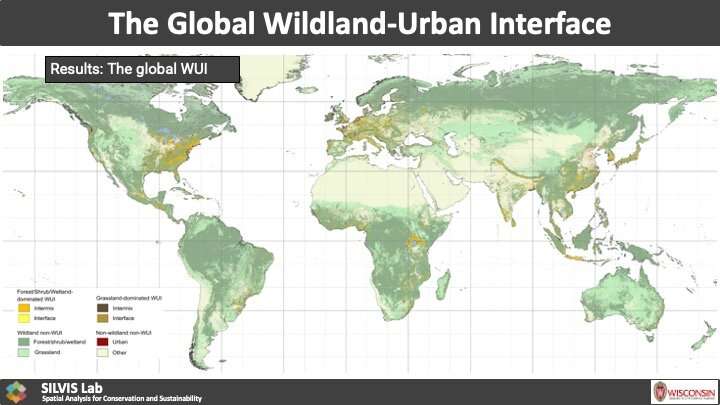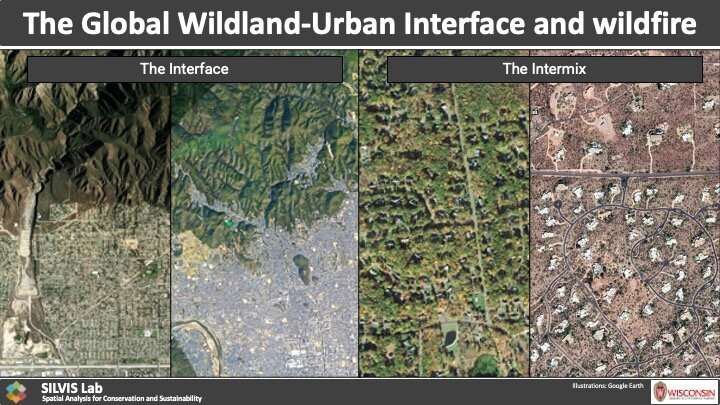This article has been reviewed according to Science X's editorial process and policies. Editors have highlighted the following attributes while ensuring the content's credibility:
fact-checked
peer-reviewed publication
trusted source
proofread
Picturing where wildlands and people meet at a global scale

Researchers led by a team at the University of Wisconsin–Madison have created the first tool to map and visualize the areas where human settlements and nature meet on a global scale. The tool, which was part of a study recently published in Nature, could improve responses to environmental conflicts like wildfires, the spread of zoonotic diseases and loss of ecosystem biodiversity.
These areas where people and wildlands meet are called the wildland-urban interface, or WUI for short. More technically, a WUI (pronounced "woo-ee") describes anywhere that has at least one house per 40 acres and is also 50% covered by wildland vegetation such as trees, shrubland, grassland, herbaceous wetland, mangroves, moss and lichen.
Franz Schug, a postdoctoral researcher in the Department of Forest and Wildlife Ecology at UW–Madison, explains that the areas were initially used by the U.S. Forest Service to assist with wildfire management in the Western United States.
Areas defined as WUI cover only about 4.7% of land on Earth, but about half of the human population lives within them. Many people enjoy living in these places because they like to be near the amenities of nature, explains Volker Radeloff, a professor of forest and wildlife ecology at UW–Madison.
"It reflects an affinity of people to nature, which is a good thing. If people said in general, 'No, we rather not be anywhere near a forest,' I'd be more worried with that," Radeloff says.
But these areas are also hot spots for environmental conflicts like wildfires, the spread of diseases from animals, habitat fragmentation and loss of biodiversity. While climate change is projected to increase the potential environmental conflict in the WUI, population growth increases the frequency in which humans and wildlands come into contact in many places. Knowing where both is likely to happen globally is important for planning for the future.
Yet, the WUI has only been prominently described in the United States and a few other developed countries. Schug saw a gap in the research. He set out to investigate WUIs' worldwide distribution, though mapping the high-resolution, global view required him to wrangle and make sense of a lot of information.
"I think the greatest challenge is just the amount of data that went into this," he says. "We have two servers in the basement [of the lab building] that were reactivated for that purpose. I think the whole thing covers several terabytes of data processing."

After setting up the computer program, it took three months to run through all the data, flagging the regions that qualify as a WUI. The land cover and building data they fed the computer was sourced from publicly available databases and stored on large servers.
Schug was able to record previously undocumented WUI in eastern Asia, East Africa and parts of South America.
Unsurprisingly, WUI around the world don't all look the same or have the same kinds of ecosystems. If the goal is to be able to inform better management practices, Schug realized he would need to provide more context on what the kinds landscapes made up these WUIs. After all, managing rain forests is very different from managing grasslands.
"Especially in these biomes, where other studies predict that most likely climate change will have an impact on fire severity and fire frequencies, where a lot of people live, they're definitely areas that will be a future interest," Schug says.
The WUI is already being leveraged in countries like Poland, Argentina and Portugal, but Radeloff and Schug see this global view as a tool that can help land managers around the world know where they need to keep an eye on in the future.
As the climate changes, some of these biomes will see more wildfires, more people and animals coming into contact with each other for the first time and more opportunities for the spread of disease and ecosystem disruption.
Schug hopes this work will inspire further regionalized research around the WUIs they've documented, empowering local land managers to better prepare for change.
To learn more about the global distribution of wildlife-urban interfaces, explore the team's interactive tool online.
More information: Franz Schug et al, The global wildland–urban interface, Nature (2023). DOI: 10.1038/s41586-023-06320-0
Journal information: Nature
Provided by University of Wisconsin-Madison





















